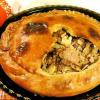The Tale of Peter and Fevronia of Murom
You can get acquainted with the story of the life and love of Saints Peter and Fevronia by reading “The Tale of Peter and Fevronia of Murom”. This is a literary adaptation of a legend beloved by the Russian people, performed by order of Metropolitan Macarius by the writer and publicist Ermolai-Erasmus for the Moscow Church Council of 1547. At this cathedral the holy Murom spouses were canonized.
“The Tale of Peter and Fevronia of Murom,” which tells about the life of Prince Peter and his wife Princess Fevronia, has become a hymn to marital love and fidelity. The Russian people loved to read the story of the Murom miracle worker saints - hundreds of copies of this work in the 16th-17th centuries speak of the popularity of the work of Ermolai-Erasmus. But this love story is also interesting to our contemporaries, especially now, when in Russia the Day of Peter and Fevronia of Murom (July 8) began to be celebrated in 2008 as the Day of Family, Love and Fidelity.
Below is a modern Russian-language version of “The Tale of Peter and Fevronia of Murom” (the original story was written in Old Russian).
YERMOLAI-ERAZM
THE TALE OF PETER AND FEVRONIYA OF MUROM
THE NARRATIVE OF THE LIFE OF THE NEW MUROOM HOLY WONDERWORKERS, THE BLESSED, AND REVEREND, AND PRAISE-WORTHY PRINCE PETER, CALLED DAVID, AND HIS WIFE, THE BLESSED, AND REVEREND, AND PRAISE-WORTHY PRINCESS FEVRONIYA, CALLED EPHROSYNE IN MONSTITUDE, BLESS, FATHER
There is a city in Russian land called Murom. It was once ruled by a noble prince named Pavel. The devil, who has hated the human race from time immemorial, made it so that the winged serpent began to fly to the wife of that prince for fornication. And with his magic he appeared before her in the image of the prince himself. This obsession continued for a long time. The wife did not hide this and told the prince and her husband about everything that happened to her. The evil snake took possession of her by force.
The prince began to think about what to do with the snake, but was at a loss. And so he says to his wife: “I’m thinking about it, wife, but I can’t figure out how to defeat this villain? I don't know how to kill him? When he begins to talk to you, ask him, seducing him, about this: does this villain himself know why his death should happen? If you find out about this and tell us, then you will be freed not only in this life from its stinking breath and hissing and all this shamelessness, which is shameful even to talk about, but also in the future life of the unhypocritical judge, Christ, thereby you will appease.” The wife firmly imprinted her husband’s words in her heart and she decided: “I will definitely do this.”
And then one day, when this evil snake came to her, she, holding her husband’s words tightly in her heart, turned to this villain with flattering speeches, talking about this and that, and in the end, with respect, praising him, asking: “A lot of things.” you know, but do you know about your death - what it will be like and from what?” He, an evil deceiver, was deceived by the forgivable deception of his faithful wife, for, neglecting the fact that he was revealing the secret to her, he said: “I am destined to die from Peter’s shoulder and from Agrikov’s sword.” The wife, having heard these words, firmly remembered them in her heart and, when this villain left, she told the prince, her husband, what the snake had told her. The prince, having heard this, was perplexed - what does it mean: death from Peter’s shoulder and from Agrikov’s sword?
And the prince had a brother named Peter. One day Paul called him to him and began to tell him about the words of the serpent, which he said to his wife. Prince Peter, having heard from his brother that the serpent had called the one by whose hand he was to die by his name, began to think without hesitation or doubt how to kill the serpent. Only one thing confused him - he didn’t know anything about Agric’s sword.
It was Peter's custom to walk alone in churches. And outside the city stood in a convent the Church of the Exaltation of the Honest and Life-Giving Cross. He came there alone to pray. And then the youth appeared to him, saying: “Prince! Do you want me to show you Agrikov’s sword?” He, trying to fulfill his plan, replied: “Let me see where he is!” The boy said: “Follow me.” And he showed the prince a gap in the altar wall between the slabs, and in it lay a sword. Then the noble prince Peter took that sword, went to his brother and told him about everything. And from that day he began to look for a suitable opportunity to kill the snake.
Every day Peter went to his brother and his daughter-in-law to pay homage to them. One day he happened to come to his brother’s chambers, and immediately he went from him to his daughter-in-law in other chambers and saw that his brother was sitting with her. And, going back from her, he met one of his brother’s servants and said to him: “I went out from my brother to my daughter-in-law, and my brother remained in his chambers, and I, without stopping anywhere, quickly came to my daughter-in-law’s chambers.” and I don’t understand how my brother ended up in my daughter-in-law’s chambers before me?” The same man said to him: “Sir, after your departure your brother did not leave his chambers!” Then Peter realized that these were the wiles of the evil serpent. And he came to his brother and said to him: “When did you come here? After all, when I left these chambers from you and, without stopping anywhere, came to your wife’s chambers, I saw you sitting with her and was very surprised how you came before me. And so I came here again, without stopping anywhere, but you, I don’t understand how, got ahead of me and ended up here before me?” Paul answered: “Brother, I did not leave these chambers anywhere after you left, nor did I visit my wife.” Then Prince Peter said: “This, brother, is the machinations of the evil serpent - you appear to me, so that I do not decide to kill him, thinking that it is you who are my brother. Now, brother, don’t go anywhere from here, I’ll go there to fight the snake, I hope that with God’s help this evil snake will be killed.”
And, taking the sword called Agrikov, he came to his daughter-in-law’s chambers and saw a serpent in the form of his brother, but, firmly convinced that it was not his brother, but an insidious serpent, he struck him with the sword. The serpent, turning into its natural form, trembled and died, sprinkling the blessed Prince Peter with its blood. Peter, from that evil blood, became covered with scabs, and ulcers appeared on his body, and a serious illness seized him. And he tried to find healing from many doctors in his domain, but not one cured him.
Peter heard that there were many doctors in the Ryazan land, and ordered him to be taken there - due to a serious illness, he himself could not sit on a horse. And when they brought him to the Ryazan land, he sent all his close associates to look for doctors.
One of the princely youths wandered into a village called Laskovo. He came to the gate of one house and saw no one. And he went into the house, but no one came out to meet him. Then he entered the upper room and saw an amazing sight: a girl was sitting alone at a loom, weaving canvas, and a hare was jumping in front of her.
And the girl said: “It’s bad when the house has no ears, and the room has no eyes!” The young man, not understanding these words, asked the girl: “Where is the owner of this house?” To this she replied: “My father and mother went to cry on loan, but my brother went through the legs of death to look into the eyes.”
The young man did not understand the girl’s words, he was amazed, seeing and hearing such miracles, and asked the girl: “I came in to you and saw that you were weaving, and a hare was jumping in front of you, and I heard some strange speeches from your lips and I can't understand what you're saying. First you said: it’s bad when the house has no ears and the room has no eyes. About her father and mother she said that they went on loan to cry, but about her brother she said - “he looks into the eyes of death through the legs.” And I didn’t understand a single word of yours!”
She told him: “And you can’t understand this! You came to this house, and entered my upper room, and found me in an unkempt state. If there was a dog in our house, it would sense that you were approaching the house and would bark at you: these are the ears of the house. And if there was a child in my upper room, then, seeing that you were going to the upper room, he would tell me about this: these are the eyes of the house. And what I told you about my father and mother and about my brother, that my father and mother went to cry - they went to a funeral and mourned the deceased there. And when death comes for them, others will mourn them: this is crying on loan. I told you this about my brother because my father and brother are tree climbers, they collect honey from trees in the forest. And today my brother went to be a beekeeper, and when he climbs up a tree, he will look through his legs to the ground so as not to fall from his height. If anyone breaks down, he will lose his life. That’s why I said that he went through the legs of death to look into the eyes.”
The young man says to her: “I see, girl, that you are wise. Tell me your name." She replied: “My name is Fevronia.” And that young man said to her: “I am the servant of the Murom prince Peter. My prince is seriously ill, with ulcers. He was covered with scabs from the blood of the evil flying snake, which he killed with his own hand. In his principality, he sought healing from many doctors, but no one could cure him. Therefore, he ordered to bring himself here, since he had heard that there were many doctors here. But we don’t know their names or where they live, so we ask about them.” To this she replied: “If someone asked for your prince, he could cure him.” The young man said: “What are you saying - who can claim my prince for himself! If anyone cures him, the prince will richly reward him. But tell me the name of the doctor, who he is and where his house is.” She answered: “Bring your prince here. If he is sincere and humble in his words, he will be healthy!”
The young man quickly returned to his prince and told him in detail about everything he had seen and heard. The noble Prince Peter commanded: “Take me to where this girl is.” And they brought him to the house where the girl lived. And he sent one of his servants to ask: “Tell me, girl, who wants to cure me? Let him heal and receive a rich reward.” She answered bluntly: “I want to cure him, but I don’t demand any reward from him. Here is my word to him: if I do not become his wife, then it is not right for me to treat him.” And the man returned and told his prince what the girl had told him.
Prince Peter treated her words with disdain and thought: “Well, how is it possible for the prince to take the daughter of a poison dart frog as his wife!” And he sent to her, saying: “Tell her - let her heal as best she can. If she cures me, I will take her as my wife.” They came to her and conveyed these words. She, taking a small bowl, scooped up some leaven with it, blew on it and said: “Let them heat your prince’s bathhouse, and let him anoint his whole body with it, where there are scabs and ulcers. And let him leave one scab unanointed. And he will be healthy!”
And they brought this ointment to the prince, and he ordered the bathhouse to be heated. He wanted to test the girl’s answers to see if she was as wise as he had heard about her speeches from his youth. He sent a small bundle of flax to her with one of his servants, saying: “This girl wants to become my wife for the sake of her wisdom. If she is so wise, let her make me a shirt, and clothes, and a scarf from this flax while I am in the bathhouse.” The servant brought Fevronia a bunch of flax and, handing it to her, conveyed the prince’s order. She told the servant: “Climb onto our stove and, taking off the log, bring it here.” He, having listened to her, brought some logs. Then she, measuring with a span, said: “Bran off this from the log.” He cut it off. She tells him: “Take this stump of wood, go and give it to your prince from me and tell him: while I comb this bunch of flax, let your prince make a weaving mill from this stump and all the other equipment that will be used for weaving.” canvas for him." The servant brought a stump of logs to his prince and conveyed the girl’s words. The prince says: “Go tell the girl that it is impossible to make what she asks from such a small chick in such a short time!” The servant came and conveyed to her the prince’s words. The girl answered: “Is it really possible for an adult man to make a shirt, a dress, and a scarf from one bunch of flax in the short time it takes him to wash in the bathhouse?” The servant left and conveyed these words to the prince. The prince was amazed at her answer.
Then Prince Peter went to the bathhouse to wash and, as the girl ordered, he anointed his sores and scabs with ointment. And he left one scab unanointed, as the girl ordered. And when I left the bathhouse, I no longer felt any illness. The next morning he looks - his whole body is healthy and clean, only one scab remains, which he did not anoint, as the girl punished him. And he marveled at such a quick healing. But he did not want to take her as his wife because of her origin, but sent her gifts. She didn't accept it.
Prince Peter went to his patrimony, the city of Murom, having recovered. Only one scab remained on him, which was not anointed at the girl’s command. And from that scab new scabs appeared all over his body from the day he went to his patrimony. And again he was covered all over with scabs and ulcers, just like the first time.
And again the prince returned to the girl for the tried and tested treatment. And when he came to her house, he sent to her in shame, asking for healing. She, not at all angry, said: “If he becomes my husband, he will be healed.” He gave her a firm word that he would take her as his wife. And again, as before, she prescribed the same treatment for him, which I already wrote about before. He, having quickly recovered, took her as his wife. This is how Fevronia became a princess.
And they arrived at their patrimony, the city of Murom, and began to live piously, without breaking God’s commandments in anything.
After a short time, Prince Pavel died. The noble Prince Peter, after his brother, became autocrat in his city.
The boyars, at the instigation of their wives, did not love Princess Fevronia, because she did not become a princess by birth, but God glorified her for the sake of her good life.
One day, one of those serving her came to the blessed Prince Peter and said to her: “Every time,” he said, “after finishing a meal, she leaves the table inappropriately: before getting up, she collects crumbs in her hand, as if she were hungry.” ! And so the noble prince Peter, wanting to test her, ordered that she dine with him at the same table. And when dinner was over, she, as was her custom, collected the crumbs in her hand. Then Prince Peter took Fevronia by the hand and, opening it, saw fragrant incense and incense. And from that day on, he never experienced it again.
A lot of time passed, and then one day his boyars came to the prince in anger and said: “Prince, we are all ready to serve you faithfully and have you as autocrat, but we do not want Princess Fevronia to rule over our wives. If you want to remain an autocrat, let you have another princess. Fevronia, having taken as much wealth as she wants, let her go wherever she wants!” Blessed Peter, whose custom was not to be angry at anything, answered with meekness: “Tell Fevronia about this, let’s listen to what she says.”
The frantic boyars, having lost their shame, decided to throw a feast. They began to feast and, when they became drunk, they began to conduct their shameless speeches, like barking dogs, denying God’s gift to Saint Fevronia to heal, which God awarded her even after death. And they say: “Madam Princess Fevronia! The whole city and the boyars are asking you: give us whoever we ask you for!” She answered: “Take whoever you ask!” They, as if with one mouth, said: “We, madam, all want Prince Peter to rule over us, but our wives do not want you to rule over them. Having taken as much wealth as you need, go wherever you want!” Then she said: “I promised you that whatever you ask, you will receive. Now I tell you: promise to give me whatever I ask you.” They, the villains, rejoiced, not knowing what awaited them, and swore: “Whatever you name, you will immediately receive it without question.” Then she says: “I ask for nothing else, only my husband, Prince Peter!” They answered: “If he wants to, we won’t say a word to you.” The enemy clouded their minds - everyone thought that if Prince Peter was not there, they would have to install another autocrat: but in their souls, each of the boyars hoped to become an autocrat.
Blessed Prince Peter did not want to break God’s commandments for the sake of reigning in this life; he lived according to God’s commandments, keeping them, as the God-voiced Matthew says in his Annunciation. After all, it is said that if someone drives away his wife, who has not been accused of adultery, and marries another, he himself commits adultery. This blessed prince acted according to the Gospel: he neglected his reign, so as not to break God’s commandments.
These evil boyars prepared ships for them on the river - a river called the Oka flows under this city. And so they sailed down the river in ships. A certain man was sailing in the same ship with Fevronia, whose wife was on the same ship. And this man, tempted by the evil demon, looked at the saint with thoughts. She, immediately guessing his evil thoughts, denounced him, telling him: “Scoop up water from this river from this side of this vessel.” He got it. And she ordered him to drink. He drank. Then she said again: “Now scoop up water from the other side of this vessel.” He got it. And she ordered him to drink again. He drank. Then she asked: “Is the water the same or is one sweeter than the other?” He answered: “The same water, lady.” After this she said: “So the female nature is the same. Why, having forgotten about your wife, are you thinking about someone else’s?” And this man, realizing that she had the gift of insight, did not dare to indulge in such thoughts anymore.
When evening came, they landed on the shore and began to settle down for the night. Blessed Prince Peter thought: “What will happen now, since I voluntarily renounced the princedom?” Precious Fevronia tells him: “Do not grieve, prince, the merciful God, the creator and protector of all will not leave us in trouble!”
Meanwhile, on the shore, food was being prepared for Prince Peter’s dinner. And his cook cut down small trees to hang the cauldrons on. And when dinner was over, the holy princess Fevronia, who was walking along the shore and saw these stumps, blessed them, saying: “May they be large trees with branches and foliage in the morning.” And so it was: we got up in the morning and found large trees with branches and foliage instead of stumps.
And when people gathered to load their belongings from the shore onto ships, nobles from the city of Murom came, saying: “Our lord prince! We came to you from all the nobles and from the inhabitants of the whole city, do not leave us, your orphans, return to your reign. After all, many nobles died in the city from the sword. Each of them wanted to rule, and in the dispute they killed each other. And all those who survived, together with all the people, pray to you: Our lord prince, although we angered and offended you because we did not want Princess Fevronia to rule over our wives, but now with all our household we are your slaves and we want you to be, and we love you, and we pray that you do not leave us, your servants!”
Blessed Prince Peter and Blessed Princess Fevronia returned to their city. And they ruled in that city, observing all the commandments and instructions of the Lord impeccably, praying incessantly and giving alms to all the people under their authority, like a child-loving father and mother. They had equal love for everyone, did not like cruelty and money-grubbing, did not spare perishable wealth, but grew rich in God's wealth. And they were true shepherds for their city, and not like mercenaries. And they ruled their city with justice and meekness, and not with rage. They welcomed strangers, fed the hungry, clothed the naked, and delivered the poor from misfortunes.
When the time had come for their pious repose, they begged God to die at the same time. And they bequeathed that they should both be placed in one tomb, and they ordered that two coffins be made from one stone, with a thin partition between them. At one time they became monks and donned monastic robes. And the blessed prince Peter was named David in the monastic rank, and the Monk Fevronia in the monastic rank was called Euphrosyne.
At a time when the Venerable and Blessed Fevronia, named Euphrosyne, was embroidering the faces of saints in the air for the cathedral church of the Most Pure Theotokos, the Venerable and Blessed Prince Peter, named David, sent to her to say: “O Sister Euphrosyne! The time of death has come, but I’m waiting for you so that we can go to God together.” She answered: “Wait, sir, until I bring air into the holy church.” He sent a second time to say: “I can’t wait for you for long.” And for the third time he sent me to say: “I’m already dying and I can’t wait any longer!” At that time she was finishing the embroidery of that holy air: only one saint’s mantle had not yet been finished, but she had already embroidered the face; and she stopped, and stuck her needle in the air, and wound the thread with which she was embroidering around it. And she sent to tell blessed Peter, named David, that she was dying with him. And, having prayed, they both gave their holy souls into the hands of God on the twenty-fifth day of the month of June.
After their repose, people decided to bury the body of blessed Prince Peter in the city, near the cathedral church of the Most Pure Mother of God, and to bury Fevronia in a country nunnery, near the Church of the Exaltation of the Honest and Life-Giving Cross, saying that since they became monks, they cannot be put in one coffin . And they made separate coffins for them, in which they placed their bodies: the body of St. Peter, named David, was placed in his coffin and placed until the morning in the city church of the Holy Mother of God, and the body of St. Fevronia, named Euphrosyne, was placed in her coffin and placed in the country church Exaltation of an honest and life-giving cross. Their common coffin, which they themselves ordered to be carved out of one stone, remained empty in the same city cathedral church of the Most Pure Mother of God. But the next morning, people saw that the separate coffins in which they had placed them were empty, and their holy bodies were found in the city cathedral church of the Most Pure Mother of God in their common coffin, which they ordered to be made for themselves during their lifetime. Foolish people, both during their lifetime and after the honest repose of Peter and Fevronia, tried to separate them: they again put them in separate coffins and separated them again. And again in the morning the saints found themselves in a single coffin. And after that they no longer dared to touch their holy bodies and buried them near the city cathedral church of the Nativity of the Holy Mother of God, as they themselves commanded - in a single coffin, which God gave for enlightenment and for the salvation of that city: those who fell with faith to the shrine with their relics generously find healing.
Let us, according to our strength, give them praise.
Rejoice, Peter, for you have been given from God the power to kill the flying fierce serpent! Rejoice, Fevronia, for in your woman’s head was the wisdom of holy men! Rejoice, Peter, for, bearing scabs and ulcers on his body, he bravely endured all the torments! Rejoice, Fevronia, for already as a girl you possessed the gift given to you by God to heal ailments! Rejoice, illustrious Peter, for, for the sake of God’s commandment not to leave his wife, he voluntarily renounced power! Rejoice, wonderful Fevronia, for with your blessing, in one night the small trees grew large, covered with branches and leaves! Rejoice, honest leaders, for in your reign you lived with humility, in prayers, doing alms, without being arrogant; For this, Christ has overshadowed you with His grace, so that even after death your bodies lie inseparably in one tomb, and in spirit you stand before the Lord Christ! Rejoice, reverend and blessed ones, for even after death you invisibly heal those who come to you with faith!
We pray to you, O blessed spouses, that you also pray for us, who honor your memory with faith!
Remember also me, a sinner, who wrote everything that I heard about you, not knowing whether others who knew more than me wrote about you or not. Although I am a sinner and an ignorant person, trusting in God’s grace and his generosity and trusting in your prayers to Christ, I worked on my work. While I wanted to give you praise on earth, I have not yet touched upon real praise. For the sake of your meek reign and righteous life, I wanted to weave wreaths of praise for you after your death, but I haven’t really touched on this yet. For you are glorified and crowned in heaven with true incorruptible crowns by the common ruler of all, Christ. To him belongs, together with his beginningless Father and the most holy, good and life-giving Spirit, all glory, honor and worship, now and ever, and unto the ages of ages. Amen.
 Probably each of us has heard the names of Peter and Fevronia, Murom miracle workers, who with their story of eternal love became a symbol of married life .
They were able to embody in her the ideals of Christian virtues: meekness, humility, love and fidelity.
Probably each of us has heard the names of Peter and Fevronia, Murom miracle workers, who with their story of eternal love became a symbol of married life .
They were able to embody in her the ideals of Christian virtues: meekness, humility, love and fidelity.
Murom has been keeping the legend of the life and death of the wonderworkers Peter and Fevronia for several centuries. They spent their entire lives on Murom land. And that's where they are now stored.
The story of their unusual life, over time, was embellished with fabulous events, and their names became a symbol of marital devotion and true love.
The legend of Peter and Fevronia was immortalized in the sixteenth century by the monk Erasmus, known in worldly life under the name of Ermolai the Sinner. He created a beautiful story dedicated to true eternal love, forgiveness, wisdom and true faith in God.
After the church decided to canonize the princes, Metropolitan Macarius ordered their names to be immortalized on paper. As a result, “The Tale of Peter and Fevronia” was written.
This happened in 1547, when the holy Murom spouses were canonized at a church council.
Peter was the younger brother of the blessed Paul, who reigned at that time in Murom. Once a misfortune happened in their family: the prodigal serpent, turning into Paul, began to visit the prince’s wife. And this obsession lasted for a long time.
The poor woman could not resist the power of the demon and succumbed to him. After which she told the prince about her meetings with the snake. Paul ordered his wife to find out from the devil's messenger the secret of his death. It turned out that the demon would die from the shoulder of Peter and Agrikov’s sword.
Pavel shared the secret of the serpent with his brother, after which Peter thought about how he could destroy his adversary. And only one thing stopped him: he did not know what kind of sword he was talking about.
Peter always loved to go to churches alone. And then one day, he decided to go to a church that was located outside the city, in a convent. During prayer, a youth appeared to him and offered to show Agrikov the sword. The prince, wanting to kill the snake, replied that he wanted to know where the sword was kept and followed him. The youth led the prince to the altar and pointed to a crack in the wall where the weapon lay.
The delighted Peter took the sword, and then went to his brother to tell him about the miracle that happened to him. From that very day he waited for the right moment to settle accounts with the serpent.
One day, Peter went into the bedchamber of Paul’s wife and found there a serpent who had taken the guise of his brother. Having made sure that it was not Paul, Peter plunged his sword into him. The serpent died, having taken on its true form, but its blood got on Peter's body and clothes. From then on, the prince began to get sick, and his body was covered with wounds and ulcers. He tried to be healed by various doctors on his land, but none of them were able to save the prince from the disease.
Life of Saint Fevronia
Peter came to terms with his illness, placing his fate in the hands of the Almighty. The Lord, loving his servant, sent him to the lands of Ryazan.
One day, the prince’s youth found himself in the village of Laskovo. He approached one of the houses, but no one came out to meet him. He went into the house, but again did not see the owners. Walking further into the upper room, the boy was amazed by an unusual sight: a girl was working on a canvas, and a hare was jumping in front of her.
Seeing the young man enter, she complained that it was bad if there were no ears in the house, and no eyes in the upper room. The boy did not understand the girl’s mysterious speeches, and asked her about the owner of the house. Her answer struck him even more; she said that his mother and father had gone to cry on borrowed time, and his brother had gone to look into the eyes of death. The young man again did not understand the girl’s words and told her about this, asking her to clarify the mysterious speeches.
Surprised that he could not understand such simple words, the girl explained to him that if she had a dog, he would have heard that someone was coming and warned about it, because the dog is the ears of the house. Ochami, she called the child who could see the guest and also warn the girl. The father and mother, as it turned out, had gone to the funeral to mourn the deceased, so that when they died, they would come to mourn them. So there is cry on loan. And the brother, being a tree climber, went to collect honey. He will have to climb tall trees and look at his feet so as not to fall. So it turns out that he is looking death in the face.
The youth marveled at the girl’s wisdom and asked her name. “Fevronya,” the girl answered.
The young man told her about the misfortune that befell Prince Peter, saying that the Lord had sent him to these lands to seek healing. So he came by order of the prince to find out about the doctors here in order to find someone who would cure the prince.
After listening to the boy, the girl ordered the prince to be brought to her, warning that he could be cured only if he was true to his words and kind in heart.
Meet the Saints
Peter could no longer walk on his own. Therefore, when they brought him to the house, he asked the servant to find out who would undertake the treatment. He promised to reward the one who healed him generously.
Fevronia said that she herself wanted to treat him, and she did not need a reward. But if he wants to be healed, he must marry her, otherwise she will not help him. The prince decided to deceive Fevronia, promising to marry, and after being cured, to abandon his promise.
The girl took the leaven from the bread, blew on it and gave it to the prince, telling him to go to the bathhouse, and then smear all the ulcers with this mixture, and leave one.
The prince decided to test the girl’s wisdom. He handed her a small bundle of flax, telling her to weave a scarf and a shirt for him while he was in the bathhouse. The servant handed this bunch to the girl along with the prince's order.
Fevronia asked the servant to bring a small log, after which she chopped off a sliver from it and gave it to the prince. Together with the sliver, she gave Peter the order to make a loom and all the equipment from this piece of wood, so that she could weave clothes for him on this loom. And it needs to be done in the time it takes her to tear the flax.
The servant gave the prince a sliver of wood, conveying the girl’s answer. Peter sent the servant back to the girl, saying that it was impossible to make a machine out of a piece of wood chips. After listening to the prince’s answer, Fevronia replied: “How can you make clothes for a man from a small amount of flax in such a short time?”
The servant conveyed the girl’s answer to the prince, but Peter was surprised at her wisdom.
Listen to the akathist to Peter and Fevronia
Miraculous healing of Peter
The prince did everything as the girl told him: first he washed himself, then he smeared all the scabs except one with leaven from bread. Coming out of the bath, he no longer felt pain, and his skin was free of scabs.
It was not by chance that the wise Fevronia, following the experience of her ancestors, prescribed him such treatment. The Savior, while healing the sick and healing bodily wounds, also healed the soul. So the girl, knowing that illnesses are given by the Almighty as a punishment for some sins, prescribed treatment for the body, in fact healing the prince’s soul. And since Fevronia foresaw that Peter would deceive her, driven by his pride, she ordered him to leave one ulcer.
The prince was amazed at such a quick healing and sent rich gifts to the girl in gratitude. Peter refused to take a commoner as his wife, since his pride and princely origin interfered with him. Fevronia did not take anything from the gifts.
Peter returned to Murom recovered, and only one scab remained on his body, reminding him of his recent illness. But as soon as he returned to his patrimony, the disease overtook him again: from the scab that remained on his body, new ulcers appeared. And after some time, the prince was again covered with ulcers and scabs.
Re-healing and wedding
And again Peter had to return to the girl for healing. Approaching her house, he sent a servant to her with words of forgiveness and a prayer for healing. Fevronia, without malice or resentment, simply answered that the prince could be healed only if he became her husband. Peter decided to take her as his wife and promised this time sincerely.

Then Fevronia, as the first time, prescribed exactly the same treatment for the prince. Now, having recovered, the prince immediately married the girl, making Fevronia a princess.
Returning to Murom, they lived happily and honestly, following the word of God in everything.
After Pavel died, Peter took his place, heading Murom. All the boyars loved and respected Peter, but their arrogant wives did not accept Fevronia. They did not want to be ruled by an ordinary peasant woman, and therefore persuaded their husbands to do dishonest things.
According to the slander of their wives, the boyars slandered Fevronia, trying to discredit her, and even started a riot, inviting the girl to leave the city, taking everything she wanted. But Fevronia only wanted to take her lover, which greatly pleased the boyars, since each of them wanted to take Peter’s place.
Marital fidelity
Saint Peter did not break God’s commandment and separate from his wife. Then he decided to leave the principality and all his treasures and go into voluntary exile with her.

Peter and Fevronia set off along the river on two ships.
One young man, who was with his wife in the same ship with the princess, fell in love with Fevronia. The girl immediately understood what he was dreaming about and asked him to pour water into a ladle and drink it, first from one side of the ship, then from the other.
The man complied with her request, and Fevronia asked if the water from the two ladles was different. The man replied that one water is no different from another. To which Fevronia said that female nature is also no different and conquered him because he dreams of her, forgetting his own wife. The convicted man understood everything and repented in his soul.
When evening came, they went ashore. Peter was very worried about what would happen to them now. Fevronia, as best she could, consoled her husband, talking about the mercy of God, making him believe in a happy outcome.
At this very time, the cook broke a couple of small trees in order to cook food with their help. When dinner was over, Fevronia blessed these branches, wishing that by morning they would turn into mature trees. This is exactly what happened in the morning. She wanted her husband to strengthen his faith by seeing this miracle.
The next day, ambassadors arrived from Murom to persuade the princes to return. It turned out that after their departure, the boyars could not share power, shed a lot of blood, and now they want to live in peace again.
Lives of the faithful spouses
The holy spouses, without any malice or resentment, accepted the invitation to return and ruled Murom for a long time and honestly, following the laws of God in everything and doing good deeds. They helped all people in need, treating their subjects with care, just as tender parents treat their children.
Regardless of their position, they treated everyone with the same love, suppressed all malice and cruelty, did not strive for worldly wealth and rejoiced in the love of God. And people loved them, because they did not refuse help to anyone, fed the hungry and clothed the naked, healed them from illnesses and guided the lost on the true path.
Blessed death
When the couple grew old, they simultaneously accepted monasticism, choosing the names David and Euphrosyne. They begged God for mercy to appear before him together, and ordered people to bury them in a common coffin, separated by a thin wall.

On the day when the Lord decided to call David to himself, the pious Euphrosyne was embroidering images of saints in the air in order to donate her needlework to the temple of the Most Holy Theotokos.
David sent a messenger to her with the news that his time had come and promised to wait for her in order to go together to the Almighty. Euphrosyne asked to be given time so that she could finish the work for the holy temple.
The prince sent a messenger a second time to say that he could not wait for her long.
When David sent a message to his beloved wife for the third time, saying that he was already dying, Euphrosyne left the unfinished work, wrapped a thread around the needle and stuck it in the air. And she sent the news to her blessed husband that she would die with him.
The couple prayed and went to God. This happened on June 25 according to the old calendar (or July 8 according to the new style).
Love is stronger than death
After the couple died, people decided that since they had taken the haircut at the end of their lives, it would be wrong to bury them together. It was decided to bury Peter in Murom, while Fevronia was laid to rest in a convent located outside the city.
Two coffins were made for them and left overnight for funeral services in different churches. The coffin, carved from a stone slab, made at their request during the couple’s lifetime, remained empty.
But when people arrived at the temples the next morning, they discovered that the coffins were empty. The bodies of Peter and Fevronia were found in a coffin, which they had prepared in advance.

Foolish people, not understanding the miracle that had occurred, again tried to separate them, but the next morning Peter and Fevronia ended up together.
After the miracle happened again, no one began to try to bury them separately. The princes were buried in a single coffin, near the Church of the Holy Mother of God.
Since then, people in need of healing have constantly come there. And if they seek help with faith in their hearts, the saints give them health and family well-being. And the story of the eternal love of Peter and Fevronia of Murom is passed down from generation to generation.
Initially, the coffin of the saints was located in the Cathedral of the Nativity of the Virgin Mary in the city of Murom. Then, when the communists came to power, they gave the remains of the princes to the local museum. The cathedral church was destroyed in the 1930s.
But already at the end of the eighties the shrine was returned to the Church.
In 1989, the relics were returned to the Church. And since 1993, the shrine with the relics of Saints Peter and Fevronia has been in the Trinity Cathedral of the Murom Holy Trinity Monastery.
Day July 8th - Feast of Peter and Fevronia
The memory of the noble princes Peter and Fevronia is celebrated on June 25 (July 8, new style). Every summer on this date (July 8), believers celebrate an amazing holiday dedicated to boundless love and eternal devotion.
In 2008 Day of Family, Love and Fidelity, officially established itself as a national holiday. On this day, Orthodox Temples hold a service dedicated to the holy spouses and once again remind all believers of their life, which is an eternal example of fidelity and love for all families.
That is why this holiday is also called the Day of Peter and Fevronia of Murom.
You can find out more about the Holy Trinity Monastery, where the miraculous relics of the blessed princes Peter and Fevronia are currently kept.
And another amazing holiday is celebrated on Murom land. On August 23, 2004, the Day of Charity and Mercy was held for the first time. It took place with the blessing of Patriarch Alexis II of Moscow and All Rus' in the Murom Diocesan Monastery (Murom, Vladimir Region).
In 1604 (400 years ago), the holy righteous Juliana Lazarevskaya (Osoryina), famous for her amazing mercy and ascetic life in the world, died. And ten years later, it was on this day, August 10/23, 1614, that the relics of the saint were found. In the same year, righteous Juliana was canonized.
Therefore, it is no coincidence that the choice of the day for the establishment of a new social and church holiday for our country fell on August 23 - the day of the discovery of the relics of the righteous saint.
You can read about other attractions of Murom and its environs, where I was able to visit.
To get the most out of the city and its surroundings, I recommend booking an apartment, room or hotel for one or more nights. Daily housing can easily be rented in Murom using the service, or through booking a hotel.
If you find yourself in Murom, be sure to take advantage of unusual excursions from the creative residents of this city. You can learn a lot of interesting things!
In the Orthodox calendar you can find one very amazing day - the holiday of Peter and Fevronia, the history of which is so beautiful and interesting that it cannot go unnoticed by the modern generation. Honoring the memory of Peter and Fevronia of Murom takes place on July 8. This date was approved in 2008 at the Russian Federation Council. The initiator of this event was the wife of Russian President Dmitry Medvedev, Svetlana. She also came up with the symbol of the holiday - daisies.
Peter and Fevronia of Murom. History of Holiness
The marital union of Peter and Fevronia became an exemplary example of Christian marriage, which is why these saints are revered as its patrons. It is very important to note that the story of Saints Peter and Fevronia will not leave a single truly Orthodox person indifferent. People perceive this holiday with great joy and response in their hearts. The story of Peter and Fevronia is simply amazing, and God’s providence is clearly visible in it.
Peter and Fevronia died on the same day - June 25, 1228 according to the old calendar according to the new one). Their bodies, left in different temples, somehow miraculously suddenly ended up in one coffin, prepared by them in advance. People regarded this as a great miracle. In 1547, Peter and Fevronia of Murom, whose history is simply amazing, were canonized. Today their holy relics are kept in the Cathedral of the Holy Trinity in the Holy Trinity Monastery in the city of Murom.
Truly, the city of Murom is rich in various epic heroes. Everyone remembers the hero Ilya Muromets very well, but few people know that his holy relics are kept in the burial caves of the Kiev Pechersk Lavra.
Poetic story
The love story of Saints Peter and Fevronia has existed for many centuries on Murom land. Over time, the true story about these faithful and reverend miracle workers acquired fabulous outlines that merged with the parables and legends of this region. Today in Murom there is a shrine with the relics of the married couple of Saints Peter and Fevronia, and pilgrims come from everywhere to honor their memory, ask for help and pray.

The story about the life of the faithful Peter and Fevronia was written by the clergyman Ermolai the Pregreshny, a brilliant writer who lived in the era of Ivan the Terrible. The story of Peter and Fevronia, in the writer’s original interpretation, acquired the colors of folklore and became a poetic story about love and wisdom, which are given only to a pure heart from God and the Holy Spirit.
About love and fidelity
This amazing story of Peter and Fevronia began at a time when Prince Pavel ruled on Russian soil in the city of Murom. And he had a beautiful wife, to whom the devil, out of his dislike and hatred of the human race, began to send a winged serpent for fornication. Using his unclean magical power, he appeared before her in the form of a prince. The wife did not hide this obsession from her husband and said that the insidious snake had mastered her by cunning. The annoyed prince did not know what to do with the villain of darkness. However, he ordered his wife to use flattering speeches to find out from the insidious tempter whether he knew from what death would come to him. When the serpent once again appeared to her, the princess found out from him that death was prepared for him at the shoulder of Petrov and Agrikov’s sword.
Savior Peter
She immediately told Prince Pavel about all this. He called his brother Peter to him and began to share his thoughts with him. Peter immediately realized that it was he who was destined to kill the serpent. However, the only thing that truly bothered him was that he did not have Agric's sword.
But at that time, Peter, completely alone, loved to go to churches and pray. One day he found himself in a convent, in the Church of the Exaltation of the Precious and Life-Giving Cross of the Lord, and a young youth approached him and told the prince that he knew where the treasured weapon was hidden. And, leading Peter to the altar wall, he pointed out to him the place between the slabs where Agrikov’s sword lay. Peter took it and went to his brother to tell him everything and think about a plan for his next actions.
And when Peter came to brother Pavel, and then went to his daughter-in-law to express his respect, he noticed that Prince Pavel, in some incredible way, was in two places at once, in his chambers and with his wife. Peter immediately saw through the serpent’s cunning in his reincarnation and, of course, not without God’s help, killed the monster.
Getting to know Fevronia
But the story of Peter and Fevronia did not end there. After the blows of the sword, the snake took on its real brutal form, trembled and died, spattering Prince Peter with its blood. From this, the whole prince was covered with fetid scabs, his body was covered with terrible ulcers. From that time on, all those close to him were knocked off their feet, they looked for doctors all over the world, but not one took up his treatment.

One day one of his youths went to the Ryazan lands, where there were many folk healers, and ended up in a small village called Laskovo, where he met a very wise young maiden named Fevronia. She promised to cure Prince Peter if he was sincere and humble in his thoughts. And she ordered him to be brought to her.
When the prince came to Fevronya, he began to promise her a huge reward. But she told him that she would cure him if he took her as his wife. And the prince lied, promising to take her as his wife for healing. Then the girl scooped up a bowl of sourdough, then blew on it and ordered the prince to heat the bath and anoint his sick body with it, but only so that one scab remained unanointed.
Peter did just that, and the illness immediately subsided. However, the prince was in no hurry to fulfill the main condition and soon became covered with sores again. Then he still had to marry Fevronia. After that, they left for Murom and lived there according to God’s commandments.
Leave to come back
After the death of Prince Paul, his brother Peter took over as ruler of the city. But the boyars did not like the princess and one day, after drinking wine for courage, they came to her and asked her to take everything that her soul desired and leave their city. But she did not take the wealth, but asked for one thing - to give her her beloved Peter.

The boyars were even delighted at this turn of affairs, because in their hearts everyone dreamed of taking the throne of the prince. Well, what's decided is decided. The pious Prince Peter did not violate the laws of God and wished to leave with his wife. They got into the boat and sailed along the Oka River. The merciful intercessor did not leave them in trouble. Having landed on one bank, they stopped for the night. The nobles from Murom immediately appeared and tearfully asked them to return, since the struggle for power led to strife and deaths between the boyars.
Blessed Peter and Fevronia with great humility returned to the city of Murom and began to rule there happily ever after. When they grew old, they decided to take a vow of monasticism, and during tonsure they received the names of David and Euphrosyne. And then together they began to pray to the Lord that He would send them death at the same time. The godly couple wanted to be buried together. A special coffin for two with a partition in the middle was even prepared in advance. But after their death, in their cells, people considered it impious to bury the monks in the same coffin and did not fulfill the will of the deceased. Their bodies were left twice in different temples, but in the morning they always somehow miraculously ended up together in the same coffin. Then it was decided to bury them together.

This is how Peter and Fevronia of Murom, whose love story deserves respect and recognition, became patrons of family, love and fidelity. And now every believer can come to the Murom Holy Trinity Convent to venerate their holy relics.
Peter and Fevronia of Murom help many Orthodox Christians. The story of eternal love will forever remain in the heart of everyone who was ever able to hear or read it.
He was raised in the Orthodox faith and chastity in the city of Murom and ruled his principality, observing strict justice in everything. When the time came, he married the blessed princess Fevronia, who also came from a pious family and was carefully instructed in piety. Being, thus, both holy and righteous people, blessed Peter and Fevronia loved purity and chastity and were always merciful, just and meek. They delivered from the power of those who offended those who had been insulted, they worthily honored persons of monastic and priestly rank, giving them material benefits, treated the poor with great mercy and diligently practiced fasting and abstinence. Desiring, according to the word of the Lord, to inherit the land of the meek and to gain for themselves the eternal bliss of the righteous, they, in addition, and in everything else, greatly pleased Christ with their good deeds. Having then reached venerable old age, blessed Peter fell into physical illness and took monastic vows, and in monasticism he was given the name of David. After this, having been a little ill, he reposed with firm faith in God in the Kingdom of Heaven. In the same way, the holy princess Fevronia, fulfilling her sincere desire, took monastic vows, receiving the monastic title of Euphrosyne and, like her husband, with unshakable faith and a clear conscience, she reposed, giving her soul into the hands of God. Thus, both holy spouses inherited the land of the meek, which they had so desired from their youth. After the death of Blessed Prince Peter, the nobles and boyars mourned him as a father, the townspeople as their intercessor and protector, the poor widows and those without food as their feeder and helper. The honorable bodies of the saints, the prince and princess, were celebrated in triumph by all the inhabitants of the city and buried in one coffin in the city of Murom. To this day, the saints, through their honest relics, perform miracles for the glory of God to those who turn to them with faith.
Troparion, tone 8:
As you were of a pious root, most honorable, having lived well in piety, blessed Peter; So also with your wise wife Fevronia, who pleased God in the world, and was honored with the life of the saints; With them, pray to the Lord to preserve your fatherland without harm, so that we may unceasingly honor you.
Kontakion, tone 8:
The reign of this world, and contemplating temporal glory, for this sake you lived piously in the world, Peter, together with your wise wife Fevronia, who pleased God with alms and prayers. Likewise, even after death, lying inseparably in the coffin, you invisibly give healing; and now pray to Christ to preserve the city and the people who glorify you.
The life story of St. miracle workers, the faithful and reverend spouses Peter and Fevronia, existed for many centuries in the traditions of the Murom land, where they lived and where their honest relics were preserved. Over time, real events acquired fabulous features, merging in people's memory with the legends and parables of this region. Now researchers are arguing about which of the historical figures the life was written about: some are inclined to think that it was Prince David and his wife Euphrosyne, monastically Peter and Fevronia, who died in 1228, others see them as the spouses Peter and Euphrosyne, who reigned in Murom in XIV century.St. blg. Prince Peter and Princess Fevronia, miracle workers of Murom (†1228) - “the most good and most pure two.” In the lives of these saints one cannot find either feats of monastic self-denial or martyrdom for the faith of Christ. They pleased God with good deeds, piety and mercy towards the poor, showed the truth of chaste love among themselves and towards their neighbors; and the Church glorified them as an example of Christian marriage. In Murom, in the Holy Trinity Convent, there is a shrine with the relics of the Murom saints Peter and Fevronia.
Pilgrims constantly come here to venerate the relics of the most famous Russian holy couple, patrons of family and marriage.
I wrote down a story about blgv. Peter and Fevronia in the 16th century. priest Ermolai the Preregrenny (monastically Erasmus), a talented writer, widely known in the era of Ivan the Terrible. Preserving folkloric features in his life, he created an amazingly poetic story about wisdom and love - the gifts of the Holy Spirit with a pure heart and humbleness in God.
St. Peter was the younger brother of the lord who reigned in the city of Murom. Pavel. One day, trouble happened in Pavel’s family - due to the devil’s obsession, a snake began to fly to his wife. The sad woman, who succumbed to demonic power, told her husband everything. The prince ordered his wife to find out the secret of his death from the villain. It turned out that the adversary’s death was “destined to come from Peter’s shoulder and Agrikov’s sword.” Having learned about this, Prince. Peter immediately decided to kill the rapist, relying on God’s help. Soon, during prayer in the temple, it was revealed where Agrikov’s sword was kept, and, having tracked down the serpent, Peter struck him down. But before his death, the snake sprinkled the winner with poisonous blood, and the prince’s body became covered with scabs and ulcers.
No one could heal Peter from a serious illness. Enduring the torment with humility, the prince surrendered to God in everything. And the Lord, providing for His servant, sent him to the Ryazan land. One of the young men sent in search of a doctor accidentally walked into the house, where he found a lonely girl named Fevronia, the daughter of a tree frog, at work, who had the gift of insight and healing. After all the questions, Fevronia ordered the servant: “Bring your prince here. If he is sincere and humble in his words, he will be healthy!”
The prince, who could no longer walk himself, was brought to the house, and he sent to ask who wanted to cure him. And he promised him that if he cured him, he would get a big reward. “I want to cure him,” Fevronia answered bluntly, “but I don’t demand any reward from him. Here’s my word to him: if I don’t become his wife, then it’s not right for me to treat him.” Peter promised to marry, but in his heart he was lying: the pride of the princely family prevented him from agreeing to such a marriage. Fevronia scooped up some sourdough, blew on it and ordered the prince to wash himself in the bathhouse and lubricate all the scabs except one.
The blessed maiden had the wisdom of the Holy Fathers and prescribed such treatment not by chance. Just as the Lord and Savior, healing lepers, the blind and the paralytic, healed the soul through bodily ailments, so Fevronia, knowing that illnesses are allowed by God as a test and for sins, prescribed treatment for the flesh, implying a spiritual meaning. Bath, according to St. To Scripture, the image of baptism and cleansing of sins (Eph. 5:26), but the Lord Himself likened to leaven the Kingdom of Heaven, which will be inherited by souls whitened by the washing of baptism (Luke 13:21). Since Fevronia saw through Peter’s wickedness and pride, she ordered him to leave one scab undone as evidence of sin. Soon, from this scab, the whole illness resumed, and the prince returned to Fevronia. The second time he kept his word. “And they arrived at their patrimony, the city of Murom, and began to live piously, without breaking God’s commandments in anything.”
After the death of his brother, Peter became autocrat in the city. The boyars respected their prince, but the arrogant boyars’ wives disliked Fevronia, not wanting to have a peasant woman as their ruler, and taught their husbands evil things. The boyars tried to level all sorts of slander against the princess, and one day they rebelled and, having lost their shame, offered Fevronia, taking whatever she wanted, to leave the city. The princess wanted nothing but her husband. The boyars rejoiced, because everyone secretly set their sights on the princely place, and they told their prince about everything. Blessed Peter, having learned that they wanted to separate him from his beloved wife, chose to voluntarily renounce power and wealth and go into exile with her.
The couple sailed down the river on two ships. A certain man, sailing with his family along with Fevronia, looked at the princess. The holy wife immediately guessed his thoughts and gently reproached him: “Draw water from one side and the other of the boat,” the princess asked. “Is the water the same or is one sweeter than the other?” “The same,” he answered. “So female nature is the same,” said Fevronia. “Why, having forgotten your wife, are you thinking about someone else’s?” The convicted person was embarrassed and repented in his soul.
In the evening they moored to the shore and began to settle down for the night. "What will happen to us now?" - Peter thought sadly, and Fevronia, a wise and kind wife, affectionately consoled him: “Do not grieve, prince, the merciful God, the Creator and Protector of all, will not leave us in trouble!” At this time, the cook began to prepare dinner and, in order to hang the cauldrons, cut down two small trees. When the meal was over, the princess blessed these stumps with the words: “May they become big trees in the morning.” And so it happened. With this miracle, she wanted to strengthen her husband, foreseeing their fate. After all, if “there is hope for a tree that, even if it is cut down, it will live again” (Job 14:7), then a person who hopes and trusts in the Lord will have a blessing both in this life and in the next.
Before they had time to wake up, ambassadors from Murom arrived, begging Peter to return to reign. The boyars quarreled over power, shed blood and were now again looking for peace and tranquility. Blzh. Peter and Fevronia humbly returned to their city and ruled happily ever after, giving alms with prayer in their hearts.
In Murom, the rule of Prince Peter was truth-loving, but without severe severity, merciful, but without weakness. The intelligent and pious princess helped her husband with advice and charitable deeds. Both lived according to the commandments of the Lord, loved everyone, but did not love either pride or unrighteous self-interest; they gave rest to wanderers, eased the lot of the unfortunate, honored the monastic and priestly ranks, protecting them from needs.
When old age came, they took monasticism with the names David and Euphrosyne and begged God to die at the same time. They decided to bury themselves together in a specially prepared coffin with a thin partition in the middle.
They died on the same day and hour, each in his own cell. People considered it impious to bury monks in the same coffin and dared to violate the will of the deceased. Twice their bodies were carried to different temples, but twice they miraculously found themselves nearby. So they buried the holy spouses together near the cathedral church of the Nativity of the Blessed Virgin Mary, and every believer received generous healing here.
“Having carried their love for each other throughout their lives, they agreed to die on the same day and hour. When Peter felt that he was dying, he sent a novice to a neighboring monastery to visit his wife. At this time, Fevronia was embroidering air (the cover of the communion cup) with gold embroidery. “Let him wait, I need to finish...” Fevronia asked to tell him. After a while, the novice came running again with the message that her husband was dying. And again Fevronia asked him to wait... And when the messenger said for the third time that the prince was leaving, Fevronia did the last stitch, stuck a needle in the sewing and “fell silent forever." They put them in coffins for the funeral service, and in the morning they found the bodies in a common coffin, which the spouses bequeathed to make before their death. The bodies were transferred to different coffins according to monastic canons, but Peter and Fevronia were again together. This happened three times. The spouses were buried together."

Reverends Peter and Fevronia of Murom. Icon with life. Icon, 1618 From the Cathedral of the Nativity of the Virgin Mary in Murom
At the Moscow Council of 1547 it was necessary to glorify them locally. Subsequently (probably from 1552) this celebration became widespread.
Today, the honest relics of the saints rest in the Holy Trinity Novodevichy Monastery in Murom and perform miracles for the glory of God to those who turn to them with faith. In their lives, they were an example of Christian marriage, ready for all hardships for the Gospel commandment of an indestructible union. And now with their prayers they bring down heavenly blessings on those entering into marriage.














